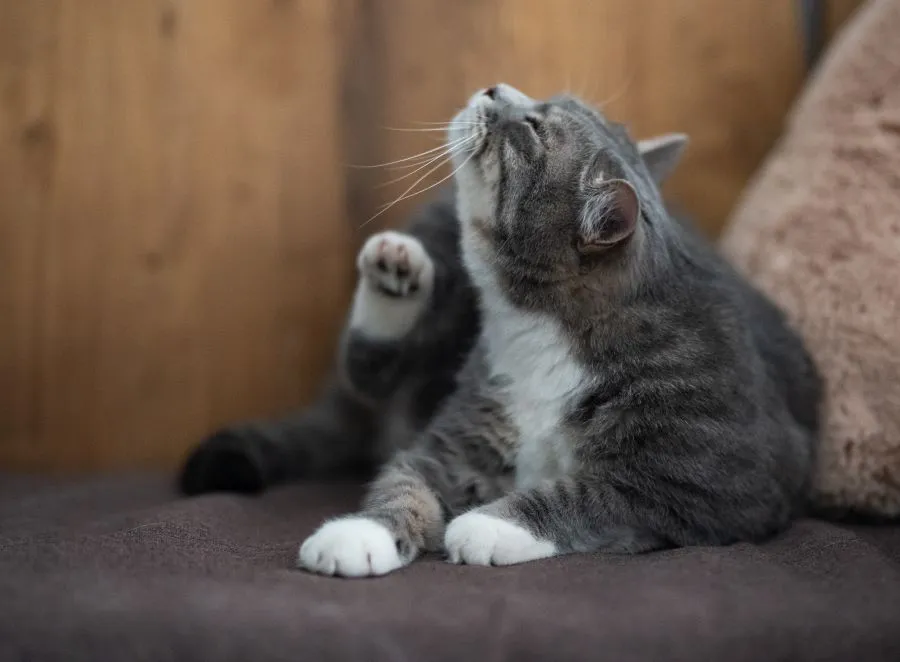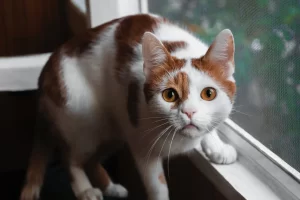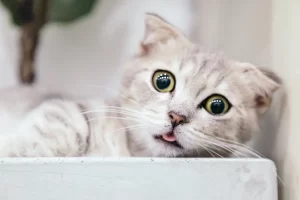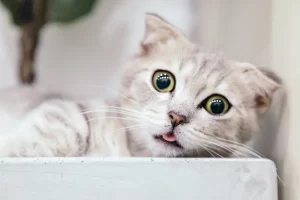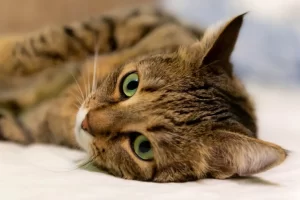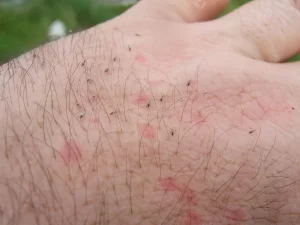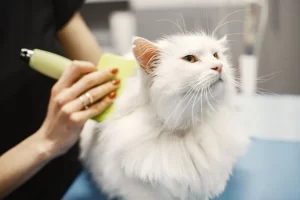Fleas are not just a nuisance for cats, but can also pose serious health risks. Understanding what fleas do to cats is crucial for cat owners to protect their feline companions from the harmful effects of flea infestations. Fleas are blood-sucking parasites that can cause a range of problems for cats, including flea-induced dermatitis, anemia, transmission of diseases, and even behavioral and psychological impact. Flea control is not just about treating the cat, but also involves environmental measures to prevent re-infestation. In this article, we will delve into the detailed and technical aspects of what fleas do to cats and the various integrated flea control strategies that can be employed to effectively manage and prevent flea infestations in cats.
Table of Contents
ToggleOverview of What Fleas Do to Cats
Flea infestations are a common problem in cats and can have significant impacts on their health and well-being. Fleas are external parasites that feed on the blood of their host, including cats. They have specialized mouthparts that allow them to pierce the skin and suck blood, causing discomfort and irritation to the cat.
One of the main consequences of flea feeding is potential allergic reactions. Flea saliva contains proteins that can trigger an allergic response in some cats, leading to flea allergy dermatitis (FAD). FAD is a hypersensitivity reaction that can cause intense itching, redness, and skin lesions in affected cats. The constant scratching and licking due to FAD can further damage the skin, leading to secondary infections and discomfort for the cat.
In addition to the allergic reactions, fleas can also cause blood loss in cats. A severe flea infestation can result in significant blood loss, especially in young kittens or cats with weakened immune systems. This blood loss can lead to anemia, a condition in which the cat has a reduced number of red blood cells, resulting in weakness, lethargy, and pale gums.
Fleas are also known to transmit diseases to cats. They can act as vectors for various disease-causing organisms, including bacteria, protozoa, and even tapeworms (Although sometimes the origin of tapeworms can be something else). For example, Bartonellosis, caused by Bartonella henselae, is a bacterial infection that can be transmitted to cats through flea bites. Mycoplasma haemofelis infection, caused by a blood-borne bacteria, is another example of a disease that can be transmitted by fleas. These diseases can cause a range of clinical signs, from mild to severe, and may require medical intervention.
The constant discomfort and irritation caused by flea infestations can also have a significant impact on a cat’s behavior and overall well-being. Cats may exhibit increased grooming behavior in an attempt to alleviate the itching and discomfort caused by fleas. This excessive grooming can result in hair loss, skin damage, and behavioral changes, such as restlessness, agitation, and anxiety.
Overall, flea infestations in cats can have several negative impacts, including allergic reactions, blood loss, transmission of diseases, skin damage, and behavioral changes. It is important to effectively manage and prevent flea infestations in cats to ensure their health and well-being. This may involve regular flea control measures, such as topical or oral flea preventives, environmental control, and consultation with a veterinarian for appropriate diagnosis and treatment.
Flea Feeding Behavior: Understanding How Fleas Feed on Cats and Their Impact
Flea feeding behavior is a complex process that involves specialized mouthparts and can have several impacts on a cat’s skin, blood, and immune response. Here’s a detailed description:
- Mouthparts: Fleas have mouthparts that are adapted for piercing and sucking blood from their host, including cats. These mouthparts consist of a needle-like structure known as the stylet, which is composed of several sharp structures, including the labium, maxillae, and mandibles. The stylet is capable of piercing the skin of the host and reaching blood vessels.
- Feeding process: Fleas typically feed by locating a suitable spot on the host’s skin, usually around the head, neck, or back, and piercing the skin with their stylet. They then inject saliva into the skin, which contains anticoagulant proteins to prevent the blood from clotting and facilitate their feeding. Fleas then use their stylet to suck up the blood from the host’s blood vessels. Fleas can consume up to 15 times their body weight in blood in a single feeding session, which can last several minutes to hours.
- Impact on skin: Flea feeding can cause various impacts on a cat’s skin. The saliva injected by fleas during feeding can trigger an immune response in the cat, leading to inflammation and irritation of the skin. This can result in redness, swelling, and itching at the feeding site. The continuous irritation from flea feeding can also cause the cat to scratch or bite the area, leading to further skin damage, such as abrasions, scabs, and open sores. In some cats, the constant irritation from flea feeding can also lead to the development of flea allergy dermatitis (FAD), as mentioned in the previous section.
- Impact on blood: Flea feeding can also impact a cat’s blood. The anticoagulant proteins in flea saliva prevent blood from clotting, allowing the fleas to feed efficiently. However, this can also result in blood loss from the host. In severe flea infestations, especially in young kittens or cats with weakened immune systems, the blood loss can be significant and result in anemia, a condition where the cat has a reduced number of red blood cells. Anemia can cause weakness, lethargy, pale gums, and other clinical signs.
- Impact on immune response: Flea feeding can also have an impact on a cat’s immune response. The injection of flea saliva into the skin can trigger an immune response, leading to the production of antibodies and inflammatory mediators. This immune response can cause localized inflammation and irritation at the feeding site. In some cases, repeated exposure to flea saliva can lead to the development of flea-specific antibodies in the cat’s blood, which may help in the diagnosis of flea infestations.
Flea Allergy Dermatitis in Cats: Understanding the Immune Response and Clinical Impacts
Flea allergy dermatitis (FAD) is a common allergic reaction triggered by flea bites in cats. It is caused by the cat’s immune system reacting to the proteins present in flea saliva, which is injected into the skin during feeding. Here’s a detailed explanation of FAD:
- Underlying immune response: When a flea bites a cat, it injects its saliva into the skin, which contains proteins that can act as allergens. In some cats, the immune system recognizes these proteins as foreign and mounts an allergic response. This response involves the production of antibodies, specifically Immunoglobulin E (IgE), which bind to the allergens and trigger the release of inflammatory mediators, such as histamine, from immune cells. These inflammatory mediators cause localized inflammation and irritation in the skin, leading to the clinical signs of FAD.
- Clinical signs: Cats with FAD typically exhibit clinical signs that are localized to the areas where fleas feed, such as the head, neck, back, and tail base. These signs may include severe itching (pruritus), redness (erythema), papules (small raised bumps), crusts, and self-inflicted hair loss (alopecia). In some cases, the skin may become thickened and darkened (hyperpigmentation), and secondary bacterial infections may develop due to the cat’s excessive scratching and grooming. FAD can be extremely uncomfortable for affected cats, and they may engage in excessive grooming or scratching behavior, leading to further skin damage.
- Long-term effects on skin health: FAD can have long-term effects on a cat’s skin health. The repeated exposure to flea saliva and the resulting immune response can cause chronic inflammation in the skin, leading to damage to the skin barrier and disruption of the normal skin structure and function. Over time, this can result in changes to the skin, such as thickening, scaling, and increased susceptibility to other skin infections. The constant itching and scratching associated with FAD can also traumatize the skin, leading to the development of open sores, scabs, and other skin lesions. In severe cases, the skin may become scarred and damaged, which can have long-term consequences for a cat’s skin health and overall well-being.
Flea-Induced Anemia in Cats: Understanding the Consequences of Blood Loss
Severe flea infestations can lead to blood loss in cats, which can result in anemia. Anemia is a condition characterized by a decrease in the number of red blood cells or a decrease in the amount of hemoglobin in the blood. Fleas are ectoparasites that feed on blood, and a heavy flea infestation can cause significant blood loss in a cat, especially in young or small cats, or in cases of severe infestation. Here’s a detailed explanation of the impact of flea-induced anemia on cats:
- Blood loss: Fleas have specialized mouthparts that allow them to pierce the skin and feed on blood. When fleas bite and feed on a cat, they consume a small amount of blood with each bite. In cases of severe infestation, where a large number of fleas are feeding on a cat, the cumulative blood loss can be significant. This can lead to a decrease in the number of red blood cells and a decrease in the amount of hemoglobin in the blood, resulting in anemia.
- Consequences of anemia: Anemia can have a range of consequences on a cat’s health and well-being. The decrease in red blood cells and hemoglobin can impair the blood’s ability to carry oxygen to tissues and organs, leading to a decrease in oxygen supply to the body’s cells. This can result in weakness, lethargy, and reduced energy levels in affected cats. Cats with anemia may also exhibit pale gums, as the decreased hemoglobin levels result in a paler coloration of the gums compared to healthy cats. In severe cases, anemia can be life-threatening, especially in young or debilitated cats or in cases where the flea infestation is not promptly addressed.
- Treatment and prevention: Treatment and prevention of flea-induced anemia involve effective flea control measures. This includes regular use of flea preventives, such as topical or oral medications, as prescribed by a veterinarian, to kill fleas and prevent infestations. Environmental control measures, such as regular vacuuming, washing bedding, and treating the indoor and outdoor environment, are also important to eliminate fleas at all life stages. In severe cases of anemia, affected cats may require additional medical intervention, such as blood transfusions, to restore their red blood cell count and hemoglobin levels.
Flea-Borne Diseases in Cats: Understanding Transmission, Clinical Signs, and Management
Fleas are not just a nuisance to cats, but they can also transmit various diseases. Here’s an in-depth overview of some of the common flea-borne diseases in cats:
- Bartonellosis: Bartonellosis is a bacterial infection caused by Bartonella species, including Bartonella henselae and Bartonella clarridgeiae, which can be transmitted to cats through flea bites. Clinical signs of bartonellosis in cats can vary and may include fever, swollen lymph nodes, lethargy, oral ulcers, and joint pain. In severe cases, bartonellosis can cause more serious complications, such as endocarditis (inflammation of the heart lining) and uveitis (inflammation of the eyes). Diagnosis is typically based on clinical signs and confirmed through blood tests or PCR testing. Treatment may involve antibiotics, and flea control measures are crucial to prevent re-infection.
- Mycoplasma haemofelis infection: Mycoplasma haemofelis is a type of bacteria that can infect a cat’s red blood cells, leading to a condition known as feline hemotropic mycoplasmosis. Fleas can transmit this bacteria to cats during feeding. Clinical signs of Mycoplasma haemofelis infection can include anemia, lethargy, fever, and pale gums. Diagnosis is typically based on blood tests, including PCR testing. Treatment may involve antibiotics, blood transfusions in severe cases, and effective flea control measures.
- Rickettsia infection: Rickettsia species, such as Rickettsia felis, can be transmitted to cats through flea bites. Rickettsial infections can cause a range of clinical signs in cats, including fever, lethargy, loss of appetite, muscle pain, and respiratory distress. Diagnosis is typically based on clinical signs and confirmed through blood tests, PCR testing, or serology. Treatment may involve antibiotics, supportive care, and flea control measures.
Prevention and management of flea-borne diseases in cats involve effective flea control measures. Regular use of flea preventives, as prescribed by a veterinarian, is crucial to prevent flea infestations and reduce the risk of disease transmission. Environmental control measures, such as regular vacuuming, washing bedding, and treating the indoor and outdoor environment, are also important to eliminate fleas at all life stages. Prompt veterinary attention is necessary if a cat shows any signs of a flea-borne disease, as early diagnosis and treatment can help prevent complications and promote recovery.
Flea Infestation Impact on Kittens
Flea infestations can be particularly risky for kittens due to their smaller size, decreased immunity, and vulnerability to blood loss. Here’s an in-depth look at the impact of flea infestations on kittens:
Kittens are more susceptible to the adverse effects of flea infestations compared to adult cats. Due to their smaller size, kittens have a lower blood volume, which means that even a relatively small amount of blood loss from flea feeding can quickly lead to anemia. Anemia is a condition characterized by a decrease in the number of red blood cells, which are responsible for carrying oxygen to the body’s tissues. Severe anemia can cause weakness, lethargy, pale gums, and even death in kittens if left untreated.
In addition to blood loss, flea infestations can also cause other health challenges in kittens. Flea bites can cause intense itching and discomfort, leading to excessive scratching and self-grooming behaviors. This can result in skin damage, open wounds, and secondary bacterial infections. Kittens also have decreased immunity compared to adult cats, which can make them more susceptible to complications from flea infestations, including bacterial infections, and may require more aggressive management. In mild cases, using some natural antibiotics might be helpful in boosting the kitten’s immune system.
Moreover, flea infestations can affect the overall growth and development of kittens. Nutritional deficiencies resulting from blood loss and decreased appetite due to discomfort from flea bites can impact a kitten’s growth rate and overall health. Flea infestations can also cause stress, discomfort, and behavioral changes in kittens, potentially affecting their socialization, behavior, and quality of life.
Given the unique risks and challenges that flea infestations pose to kittens, prompt and appropriate treatment is crucial. Kittens should be carefully evaluated by a veterinarian, who may prescribe appropriate flea preventives, medications, and supportive care tailored to their age, size, and overall health. Regular monitoring, supportive care, and environmental control measures, such as flea combing, washing bedding, and vacuuming, are important in managing flea infestations in kittens. Early intervention and preventive measures can help prevent complications and promote the health and well-being of kittens.
Flea Life Cycle and Environmental Infestation: Understanding the Challenges of Flea Control
Understanding the flea life cycle and environmental infestation is crucial in effectively managing flea infestations in cats. Here’s an in-depth look at these aspects:
- The flea life cycle consists of four stages: egg, larva, pupa, and adult. Fleas lay eggs on the host animal, which then fall off into the environment, such as carpets, bedding, furniture, and outdoor areas where the cat spends time. The eggs hatch into larvae, which feed on organic matter, including flea feces, skin debris, and blood, in the environment. The larvae then spin a cocoon and develop into pupae, which are resistant to environmental conditions and difficult to eliminate. After some time, the adult fleas emerge from the cocoon and jump onto a host, such as the cat, to start the feeding process and complete the life cycle.
- Flea infestations in the environment can pose challenges for effective control measures. The pupae, which are protected within their cocoon, can remain dormant for weeks to months, making them resistant to insecticides and other control methods. This means that even if adult fleas on the cat are eliminated, new adult fleas can continue to emerge from the environment and reinfest the cat. Additionally, flea eggs and larvae can be hidden in carpets, bedding, and furniture, making it difficult to completely eliminate them.
- To effectively manage flea infestations, it’s essential to address both the fleas on the cat and their environment. Treatment should include regular use of effective flea control products specifically designed for cats, such as topical or oral medications, under the guidance of a veterinarian. Environmental control measures should also be implemented, such as regular vacuuming of carpets, laundering bedding, and using insecticides or insect growth regulators (IGRs) to target fleas in the environment. Treating the environment and the cat concurrently is important to break the flea life cycle, prevent reinfestation, and achieve long-term control.
It’s also crucial to remember that flea control is an ongoing process and requires consistent effort. Regular monitoring, preventive measures, and timely intervention can help effectively manage flea infestations and reduce the risk of reinfestation in both the cat and the environment. Consulting with a veterinarian for tailored treatment and prevention plans is recommended for optimal flea control in cats.

Flea Resistance and Control Challenges
Flea resistance to common flea control products can pose challenges in effectively managing flea infestations in cats. Fleas can develop resistance to insecticides used in topical or oral flea control products, reducing their effectiveness. This can occur due to genetic mutations or selection pressure from the repeated use of the same class of insecticides.
Flea resistance can limit the efficacy of traditional flea control products, making it harder to eliminate fleas from the cat and the environment. In some cases, fleas may survive or reinfest even after treatment with commonly used products, leading to continued infestations and frustration for cat owners.
To address flea resistance and achieve effective flea control, an integrated approach is often necessary. This may involve using multiple classes of insecticides with different modes of action, rotating products to prevent resistance, and incorporating environmental control measures to target fleas in the environment.
Environmental control measures, such as regular vacuuming, laundering bedding, and using insecticides or insect growth regulators (IGRs), can help reduce the population of fleas in the environment, preventing their reproduction and reducing the overall flea burden. Combining environmental control measures with regular use of effective flea control products on the cat can help break the flea life cycle, prevent reinfestation, and achieve more successful flea control outcomes.
Consulting with a veterinarian is essential for developing an integrated flea control plan tailored to the individual cat’s needs. Veterinarians can provide recommendations on appropriate flea control products, dosages, and application methods, as well as guide on environmental control measures based on the specific situation. They can also monitor the effectiveness of flea control and make adjustments as needed to ensure optimal results.
Behavioral and Psychological Impact of Flea Infestations on Cats
Flea infestations can have not only physical but also behavioral and psychological impacts on cats. Cats are known for their grooming behavior, and when infested with fleas, they may exhibit increased grooming behaviors in an attempt to remove the irritating fleas from their fur. This excessive grooming can lead to hair loss, skin irritation, and even self-inflicted wounds, resulting in discomfort and pain for the cat.
Flea infestations can also cause behavioral changes in cats. Cats may become more agitated, restless, and anxious due to the constant irritation caused by fleas. They may exhibit signs of discomfort, such as frequent scratching, biting at the skin, or restlessness. These behavioral changes can negatively impact a cat’s overall well-being and quality of life, as it can disrupt their normal routine, sleep pattern, and overall mood.
Furthermore, cats with flea infestations may develop an aversion to certain areas in the home where fleas are prevalent, leading to avoidance behaviors. They may avoid resting or playing in areas where they have experienced discomfort from flea bites. This can result in a decrease in their physical activity, reduced exploration, and limited access to certain parts of the home, potentially impacting their mental and physical stimulation.
In some cases, severe flea infestations can lead to psychological distress in cats, causing them to exhibit signs of stress, anxiety, or even depression. Chronic discomfort from flea bites, skin irritation, and constant grooming can contribute to changes in a cat’s behavior, appetite, and overall demeanor.
It’s important to note that behavioral and psychological impacts of flea infestations on cats can vary depending on the individual cat’s tolerance, temperament, and overall health. Some cats may be more resilient to flea infestations, while others may be more sensitive and susceptible to the associated discomfort and stress.
To mitigate the behavioral and psychological impact of flea infestations on cats, timely and effective flea control measures are crucial. Preventing and treating flea infestations promptly can help reduce the discomfort, irritation, and psychological distress that fleas can cause in cats. Regular grooming, including flea combing, can also help physically remove fleas from the cat’s fur and provide relief. Consulting with a veterinarian for appropriate flea control products and strategies tailored to the cat’s individual needs is highly recommended.
Diagnosis and Monitoring of Flea Infestations in Cats: Methods and Importance
Diagnosing and monitoring flea infestations in cats is essential to effectively manage and control the problem. Several methods can be used to diagnose flea infestations in cats, including:
- Flea combing: This involves using a fine-toothed flea comb to comb through the cat’s fur, particularly in areas where fleas are known to hide, such as around the neck, base of the tail, and behind the ears. Fleas caught in the comb can be visualized and identified under a microscope. Flea combing is a simple and non-invasive method that can be used to quickly detect adult fleas on the cat’s fur.
- Skin scrapings: Skin scrapings involve gently scraping the surface of the cat’s skin to collect skin cells and debris, which can be examined under a microscope for the presence of flea feces or flea eggs. Skin scrapings can help identify flea infestations even if adult fleas are not readily visible on the cat’s fur.
- Serological tests: Serological tests, such as enzyme-linked immunosorbent assay (ELISA) or polymerase chain reaction (PCR), can be used to detect flea-borne pathogens, such as Bartonella spp., Mycoplasma haemofelis, or Rickettsia spp., in the cat’s blood. These tests can provide information on whether the cat has been exposed to fleas and any potential associated diseases.
In addition to diagnosing flea infestations, monitoring for ongoing flea control is crucial to ensure the effectiveness of flea prevention measures. This may involve regular flea combing to check for adult fleas, checking for flea feces or eggs in the cat’s fur, and monitoring the cat for any signs of skin irritation, excessive grooming, or other behavioral changes that may indicate a flea infestation.
Integrated Flea Control for Cats: Strategies for Effective Management
Integrated flea control strategies involve a combination of measures to effectively manage flea infestations in cats and prevent re-infestations. These may include:
- Regular grooming: Regular grooming with a flea comb can help physically remove adult fleas from the cat’s fur, reducing the flea population on the cat and preventing them from laying eggs.
- Use of appropriate flea control products: There are various flea control products available, including topical spot-on treatments, oral medications, collars, and sprays. These products can kill fleas at different life stages, such as adult fleas, flea eggs, larvae, and pupae, and can provide long-lasting protection.
- Environmental control measures: Treating the indoor and outdoor environment is crucial to prevent re-infestation. This may include vacuuming carpets, rugs, and upholstery regularly, washing bedding and other washable items in hot water, and using insecticides or insect growth regulators (IGRs) in the environment to kill fleas in different life stages.
- Veterinary guidance: Consulting with a veterinarian is important for proper diagnosis, treatment, and prevention of flea infestations in cats. Veterinarians can recommend appropriate flea control products based on the cat’s age, health status, and lifestyle, and provide guidance on environmental control measures.
- Regular monitoring: Regular monitoring for fleas on the cat, in the environment, and for any signs of flea-related diseases or skin irritation is crucial to ensure the effectiveness of flea control measures and timely intervention if needed.

